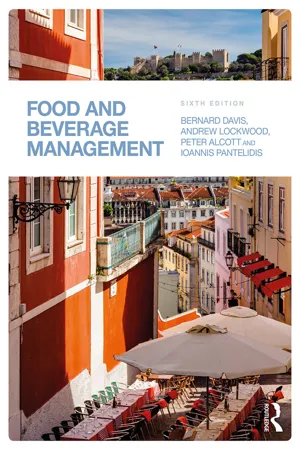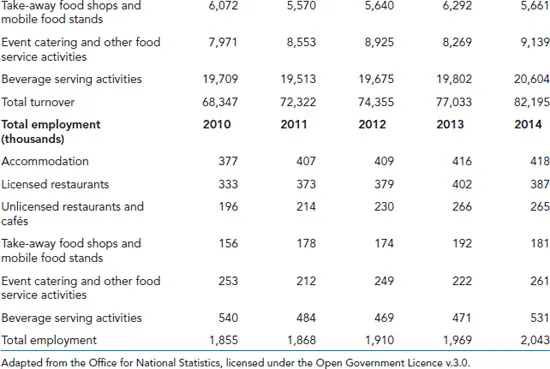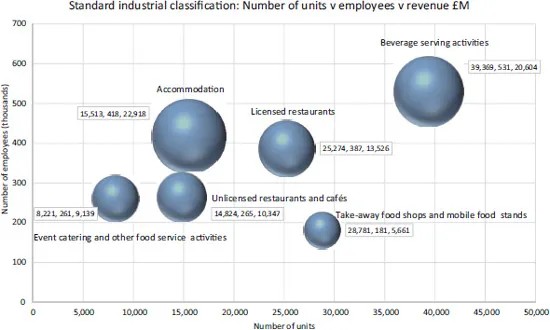
Food and Beverage Management
- 380 pages
- English
- ePUB (mobile friendly)
- Available on iOS & Android
Food and Beverage Management
About this book
This introductory textbook provides a thorough guide to the management of food and beverage outlets, from their day-to-day running through to the wider concerns of the hospitality industry. It explores the broad range of subject areas that encompass the food and beverage market and its main sectors – fast food and casual dining, hotels and quality restaurants and event, industrial and welfare catering. It also looks at some of the important trends affecting the food and beverage industry, covering consumers, the environment and ethical concerns as well as developments in technology.
New to this edition:
- New chapter: Classifying food and drink service operations.
- New international case studies throughout covering the latest industry developments within a wide range of businesses.
- Enhanced coverage of financial aspects, including forecasting and menu pricing with respective examples of costings.
- New coverage of contemporary trends, including events management, use of technology, use of social media in marketing, customer management and environmental concerns, such as sourcing, sustainability and waste management.
- Updated companion website, including new case studies, PowerPoint slides, multiple choice questions, revision notes, true or false questions, short answer questions and new video and web links per chapter.
It is illustrated in full colour and contains in-chapter activities as well as end-of-chapter summaries and revision questions to test the readers' knowledge as they progress. Written by a team of authors with many years of industry practice and teaching experience, this book is the ideal guide to the subject for hospitality students and industry practitioners alike.
Frequently asked questions
- Essential is ideal for learners and professionals who enjoy exploring a wide range of subjects. Access the Essential Library with 800,000+ trusted titles and best-sellers across business, personal growth, and the humanities. Includes unlimited reading time and Standard Read Aloud voice.
- Complete: Perfect for advanced learners and researchers needing full, unrestricted access. Unlock 1.4M+ books across hundreds of subjects, including academic and specialized titles. The Complete Plan also includes advanced features like Premium Read Aloud and Research Assistant.
Please note we cannot support devices running on iOS 13 and Android 7 or earlier. Learn more about using the app.
Information
Chapter 1
Introducing food and beverage management
Chapter objectives
- Understand the complexity of the hospitality industry.
- Identify the size and scope of food and beverage operations.
- Distinguish between market and cost orientation.
- Identify the key responsibilities of food and beverage managers and the constraints that may be placed on them.
- Explain the factors affecting the nature of the meal experience and recognize the manager’s role in ensuring coherence.
Introduction
Activity 1
Size and scope of food and beverage operations


Activity 2

Standard industrial classification
| SECTION I ACCOMMODATION AND FOOD SERVICE ACTIVITIES This section includes the provision of short-stay accommodation for visitors and other travellers and the provision of complete meals and drinks fit for immediate consumption. The amount and type of supplementary services provided within this section can vary widely. This section excludes the provision of long-term accommodation as primary residences, which is classified in real estate activities (section L). Also excluded is the preparation of food or drinks that are either not fit for immediate consumption or that are sold through independent distribution channels, i.e. through wholesale or retail trade activities. The preparation of these foods is classified in manufacturing (section C). 55 ACCOMMODATION This division includes the provision of short-stay accommodation for visitors and other travellers. Also included is the provision of longer term accommodation for students, workers and similar individuals. Some units may provide only accommodation while others provide a combination of accommodation, meals and/or recreational facilities. This division excludes activities related to the provision of long-term primary residences in facilities such as apartments typically leased on a monthly or annual basis classified in Real Estate (section L). 55.1 Hotels and similar accommodation This class includes the provision of accommodation, typically on a daily or weekly basis, principally for short stays by visitors. This includes the provision of furnished accommodation i... |
Table of contents
- Cover
- Title
- Copyright
- Dedication
- Contents
- List of figures
- List of tables
- Preface to the sixth edition
- Acknowledgements
- 1 Introducing food and beverage management
- 2 Classifying food and drink service operations
- 3 Restaurants and events – the direct market
- 4 Contract foodservice, travel and public sector catering – the indirect market
- 5 Developing the concept
- 6 The menu
- 7 Purchasing and storage
- 8 Production and service
- 9 Controlling the operation
- 10 Staffing issues
- 11 Food and beverage marketing
- 12 Managing quality in food and drink service operations
- 13 Trends and developments
- Index